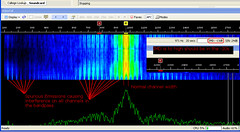An over modulated BPSK signal causes spurious emissions that cause interference to the whole band pass and then some. This happens when either the audio level output from the computer or the mic gain on the radio are set to high. It has little to do with how much RF power you are pushing. Too much power may cause inter-modulation in someones receiver which is why we always want to successfully communicate on as little power as possible. With BPSK31 you can literally talk the world over on 20 watts even when the conditions are not great.

An over modulated BPSK signal outside the band pass of the receiver can still cause interference. The amount of interference depends on the capabilities of your receiver and whether you attenuate the loud signals or not. Usually for any digital mode you do not want to attenuate the signal levels as the digital modes are intended to be low power modes and even during poor propagation they can communicate worldwide on very low power. Having to attenuate the loud signals means the low power signals will disappear off the screen.

Here is an example of how well PSK works with low power. Here I am copying 100% a signal from Warminster, PA into Fort Walton Beach, FL using my dummy load as an antenna. The station in PA said he was running 30W.
IMPORTANT SAFETY- For soundcard digital modes do not ever transmit more than 50% of your radios rated max RF power. If you have a 100W SSB radio then 50W is the max you will want to transmit with soundcard digital modes. PSK is a low power mode and you should never need more than 25W even when the conditions are poor. Ive talked to Europe from Florida on 25 W and no sunspots during the sunspot minimum of 2009 using only a dipole at 20 feet above ground. If you have a directional gain antenna you can use considerably less power.
- Do not send more power to your dummy load than it is rated for in continuous operation. Usually 1/4 of the SSB rating is all you will want to transmit. If you have a 100W dummy load then 25W is pushing the limits for continuous operation.
- Do not tune or make audio adjustments on frequencies where others are operating. While adjusting your radio you WILL cause interference to others operating in and/or near your passband. Move to a quite area where it is permissible to transmit digital modes. You can even select a band that is not open for propagation and that will further reduce the amount of interference you cause.
- Don't forget to transmit your call sign when testing and adjusting your audio levels over the air.
- Always use the lowest power possible to make the contact. If the operator on the other end keeps sending QRZ? QRZ? or QSB then you can bump your power up until they copy you.
- Make sure you turn off your operating systems default sounds. You don't want any randoms beeps and dings going off during your transmission. For best results use a separate soundcard for your radio operations. Many computer-radio interfaces have built in external soundcards so you do not have to use your computer soundcard. You will have to adjust your PSK software to use the alternate soundcard.
While monitoring your ALC manually key the transmitter in SSB mode (no audio) and slowly adjust your RF power up until your ALC level reduces to zero. If your ALC is at zero with your RF power at zero then turn your RF power up to where it would normally register a few watts on CW.
Unkey your radio.
Now slowly turn the mic gain up until the RF meter reads 10 watts carrier. If you can't obtain 10 watts before the mic gain hits 50% then slowly increase your RF gain to obtain the 10 watts. When data is actually transmitted the power level will double to about 20 watts. Check the ALC and make sure it is still at zero. Reduce the mic gain if the ALC is above zero and adjust RF gain for 10 watts.
Stop transmitting the carrier from the PSK software. (F4 on DM-780)
Now its time to send some data to see the results of these settings.
Type a few lines of "TESTING TESTING TESTING DE (YOUR CALL)" in the transmit text box of your PSK software.
Start the software transmitting (F2 on DM-780) and watch the power out level and the ALC level. The power out should peak around 20 watts and there should be no deflection of the ALC meter.
Stop the PSK software from transmitting (F4 on DM-780).

Here are the radio and soundcard settings I used to produce a 10W carrier only signal into my Kenwood TS-180S.
The red dots indicate values that you want to achieve and the blue dots represent values you adjust to achieve them.
I wanted 80% Master output from the soundcard and I wanted 20% Wave output to indicate 20 watts of radiated power. So I set the Master and Wave their respective values and adjusting the dB pad in DM 780 (PSK software) and the mic gain level I set the RF power out put to 10W on a carrier only signal. I made sure the ALC needle never moved from zero. If you can't achieve these values without ALC deflection then adjust the dB pad to the right to reduce the audio and re-adjust the mic gain for 10 watts and zero ALC.
And don't forget to hook your radio up to your antenna. Even though it is possible to hear signals with it I doubt anyone will hear you outside your own neighborhood.
Good luck and good DX.

No comments:
Post a Comment